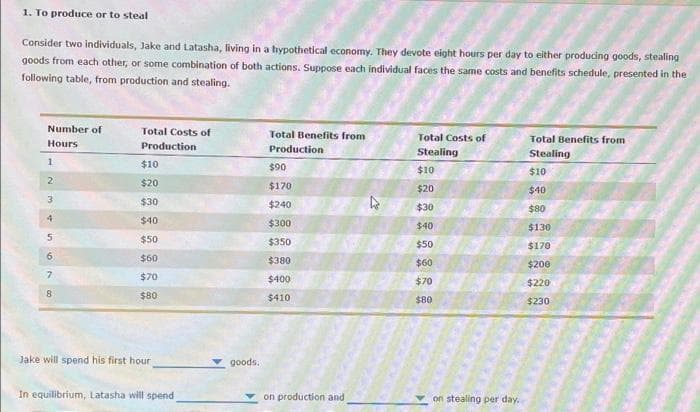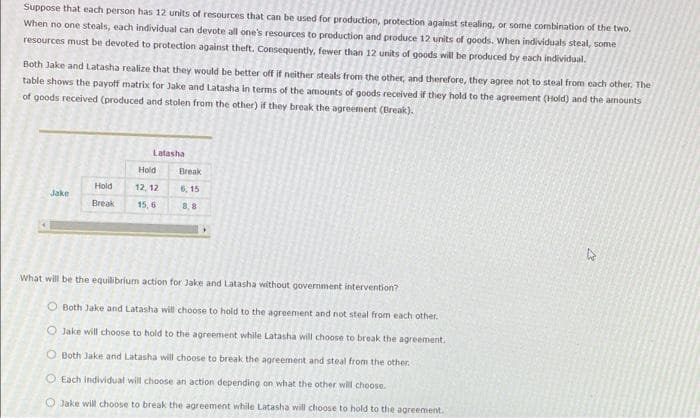Number of Total Costs of Total Benefits from Total Costs of Total Benefits from Hours Production Production Stealing Stealing $10 $90 $10 $10 $20 $170 $20 $40 3. $30 $240 $30 $80 4. $40 $300 $40 $130 $50 $350 $50 $170 6. $60 $380 $60 $200 7. $70 $400 $70 $220 $80 $410 $80 $230 Jake will spend his first hour goods. In equilibrium, Latasha will spend on production and on stealing per day.
Number of Total Costs of Total Benefits from Total Costs of Total Benefits from Hours Production Production Stealing Stealing $10 $90 $10 $10 $20 $170 $20 $40 3. $30 $240 $30 $80 4. $40 $300 $40 $130 $50 $350 $50 $170 6. $60 $380 $60 $200 7. $70 $400 $70 $220 $80 $410 $80 $230 Jake will spend his first hour goods. In equilibrium, Latasha will spend on production and on stealing per day.
Principles of Microeconomics
7th Edition
ISBN:9781305156050
Author:N. Gregory Mankiw
Publisher:N. Gregory Mankiw
Chapter3: Interdependence And The Gains From Trade
Section: Chapter Questions
Problem 3CQQ
Related questions
Question
6

Transcribed Image Text:1. To produce or to steal
Consider two individuals, Jake and Latasha, living in a tıypothetical economy. They devote eight hours per day to either producing goods, stealing
goods from each other, or some combination of both actions. Suppose each individual faces the same costs and benefits schedule, presented in the
following table, from production and stealing.
Number of
Total Costs of
Total Benefits from
Total Costs of
Total Benefits from
Hours
Production
Production
Stealing
Stealing
1.
$10
$90
$10
$10
$20
$170
$20
$40
3
$30
$240
$30
$80
4.
$40
$300
$40
$130
$50
$350
$50
$170
6.
$60
$380
$60
$200
7.
$70
$400
$70
$220
$80
$410
$80
$230
Jake will spend his first hour
goods.
In equilibrium, Latasha will spend
on production and
on stealing per day.

Transcribed Image Text:Suppose that each person has 12 units of resources that can be used for production, protection against stealing, or some combination of the two.
When no one steals, each individual can devote all one's resources to production and produce 12 units of goods. When individuals steal, some
resources must be devoted to protection against theft. Consequently, fewer than 12 units of goods will be produced by each individual.
Both Jake and Latasha realize that they would be better off if neither steals from the other, and therefore, they agree not to steal from each other. The
table shows the payoff matrix for Jake and Latasha in terms of the amounts of goods received if they hold to the agreement (Hold) and the amounts
of goods received (produced and stolen from the other) if they break the agreement (Break).
Latasha
Hold
Break
Hold
12, 12
6, 15
Jake
Break
15, 6
8,8
What will be the equilibrium action for Jake and Latasha without government intervention?
Both Jake and Latasha will choose to hold to the agreement and not steal from each other.
O Jake will choose to hold to the agreement while Latasha will choose to break the agreement.
O Both Jake and Latasha will choose to break the agreement and steal from the other.
O Each individual will choose an action depending on what the other wil choose.
O Jake will choose to break the agreement while Latasha will choose to hold to the agreement.
Expert Solution
This question has been solved!
Explore an expertly crafted, step-by-step solution for a thorough understanding of key concepts.
This is a popular solution!
Trending now
This is a popular solution!
Step by step
Solved in 2 steps

Knowledge Booster
Learn more about
Need a deep-dive on the concept behind this application? Look no further. Learn more about this topic, economics and related others by exploring similar questions and additional content below.Recommended textbooks for you

Principles of Microeconomics
Economics
ISBN:
9781305156050
Author:
N. Gregory Mankiw
Publisher:
Cengage Learning

Principles of Economics 2e
Economics
ISBN:
9781947172364
Author:
Steven A. Greenlaw; David Shapiro
Publisher:
OpenStax

Principles of Microeconomics
Economics
ISBN:
9781305156050
Author:
N. Gregory Mankiw
Publisher:
Cengage Learning

Principles of Economics 2e
Economics
ISBN:
9781947172364
Author:
Steven A. Greenlaw; David Shapiro
Publisher:
OpenStax